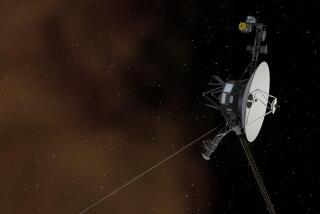Space ‘Miracle’ Revives and Boosts Wayward Satellite Into Right Orbit
- Share via
In what one official described as “nothing short of a miracle,” a satellite that drifted around the Earth for six months reached orbit Friday, and engineers found no problems at all with its sophisticated electronic components.
“We have successfully placed Leasat (3) on station,” an official with Hughes Communications of El Segundo said.
In addition to arriving on station, the satellite deployed the antenna that will be its primary communications link with the ground, and engineers successfully ran through the first in a series of tests.
After a month of testing, Hughes will turn the satellite over to the U.S. Navy and begin collecting revenues. Insurance companies, which paid Hughes $85 million after the satellite was declared a loss last April, could recoup as much as $65 million under an agreement between Hughes and the underwriters, possibly easing an insurance crisis that has threatened to paralyze the commercial satellite industry.
The upbeat end to the story caps one of the most dramatic space adventures in years.
The satellite, designed specifically for launching from the space shuttle, was spun out of the cargo bay of the Discovery last April but failed to activate itself.
In the first unscheduled spacewalk in the history of the U.S. space program, two astronauts left the security of the spacecraft to attach crude, homemade devices to the shuttle’s robotic arm so that a lever on the side of the satellite could be snagged in an effort to start the craft. The lever, however, turned out not to be the problem.
Late last month, the Discovery returned to the scene and two astronauts “hot-wired” the satellite so that ground controllers could fire the engines manually.
Hughes engineers had feared that the freezing temperatures sustained by the satellite as it drifted through the Earth’s shadow had damaged the on-board fuel system so extensively that it would explode when its main rocket motor, which is similar to the rocket used aboard intercontinental ballistic missiles, was fired from the ground. However, that turned out not to be the case.
The rocket was fired Sunday morning and worked just as it was supposed to, sending the craft up to an altitude of about 10,000 miles--nearly halfway to its assigned post 22,300 miles above the Earth, where its speed would match the Earth’s rotation, leaving it in a fixed position relative to the ground.
Into Orbit
All communications satellites are launched in a similar fashion, using the shuttle or an expendable rocket to reach low Earth orbit, then a powerful onboard rocket to climb farther up and finally smaller rockets that nudge it slowly up to geosynchronous orbit and into the right position.
Hughes, the big aerospace company based in El Segundo, has launched 61 commercial satellites to date and is the world leader in the commercial satellite business. With the recovery of Leasat 3, it has ducked one bullet, but the firm is still unable to fulfill its contract with the Navy.
Hughes was supposed to turn over four satellites to the Navy by next March, but one was lost last month when its communications payload failed after it reached its permanent station, leaving Hughes with only two functioning satellites. The rescued satellite is the third in the series, and the fourth is not scheduled for launch until September, so Hughes will not be able to meet its full contract until that time.
Hughes Ecstatic
Hughes officials, while embarrassed over the failures, are ecstatic over the successful rescue of Leasat 3.
Engineers with the company had given the rescue about an even chance of succeeding, but many expected serious problems with some of the satellite’s components. At the higher altitude over the Equator that the satellite reached Friday, it is exposed to the sun at all times, and it spins so that all surfaces will be kept warm.
However, in the low Earth orbit where it had been stranded for six months, it was subjected to temperatures as low as 35 degrees below zero while passing through the Earth’s shadow and its spin rate had slowed to near zero, leaving some areas of the satellite much colder than others.
“And after all of that, it worked,” one Hughes source said. “It’s just a miracle.”
More to Read
Sign up for Essential California
The most important California stories and recommendations in your inbox every morning.
You may occasionally receive promotional content from the Los Angeles Times.










